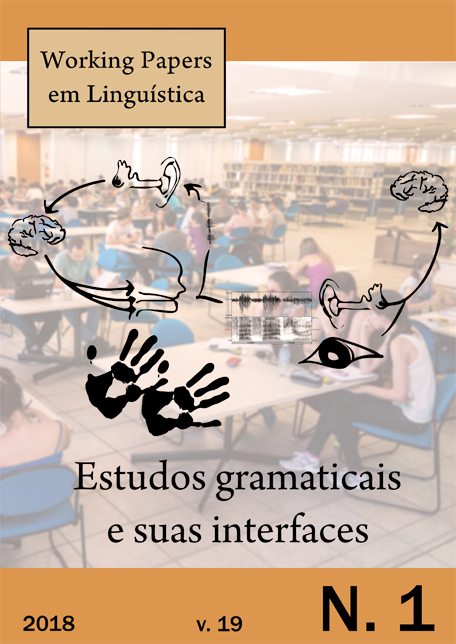A aerodinâmica das consoantes nasais [m] e [n] do português brasileiro
DOI:
https://doi.org/10.5007/1984-8420.2018v19n1p18Resumen
Este estudo tem como objetivo uma caracterização aerodinâmica das consoantes nasais [m] e [n] do português brasileiro, com o uso de tecnologias computadorizadas e coleta simultânea de dados acústicos e aerodinâmicos, em uma perspectiva dinâmica de produção da fala. As gravações envolveram cinco adultos, com idades entre 25 e 52 anos, três do sexo feminino e dois do sexo masculino. O corpus incluiu 20 logatomas em frases-veículo, variando o contexto de tonicidade e o da vogal precedente. Os dados de fala foram coletados por meio da Estação EVA (Evaluation Vocale Assistée) e do piezoelétrico. Dos dados advindos da Estação EVA, foram investigadas configurações de curvas de fluxo aéreo oral (FAO) e de fluxo aéreo nasal (FAN); e dos dados advindos do piezoelétrico, foram analisados valores das curvas de FAN. Os resultados indicaram, para ambos os sexos, semelhanças entre as consoantes [m] e [n]: muito baixa amplitude nas curvas de FAO, indicando oclusão na passagem de ar pela cavidade oral; e curvas de FAN com configuração plana em sua extensão e com maior amplitude em relação às vogais adjacentes. Assim, o comportamento aerodinâmico do FAN na produção das consoantes [m] e [n] permitiu a inferência articulatória de que o gesto vélico dessas consoantes seja formado por três tempos: abertura, platô e fechamento. Ainda, foram confirmadas diferenças significativas entre parâmetros aerodinâmicos relativos às consoantes [m] e [n], quanto ao contexto de tonicidade e ao da vogal precedente. As características aerodinâmicas apontaram, portanto, para a natureza dinâmica das consoantes nasais do português brasileiro.Descargas
Publicado
Número
Sección
Licencia
Derechos de autor 2018 Michele Gindri Vieira, Izabel Christine Seara

Esta obra está bajo una licencia internacional Creative Commons Atribución-NoComercial 4.0.
Os direitos autorais de trabalhos publicados são dos autores, que cedem à Revista Working Papers em Linguística o direito de publicação, ficando sua reimpressão, total ou parcial, sujeita à autorização expressa da Comissão Editorial da revista. Deve ser consignada a fonte de publicação original. Os nomes e endereços de e-mail neste site serão usados exclusivamente para os propósitos da revista, não estando disponíveis para outros fins.
The names and email addresses entered in this journal site will be used exclusively for the stated purposes of this journal and will not be made available for any other purpose or to any other party.
Esta obra está licenciada sob licença Creative Commons - Atribuição-NãoComercial- 4.0 Internacional.


